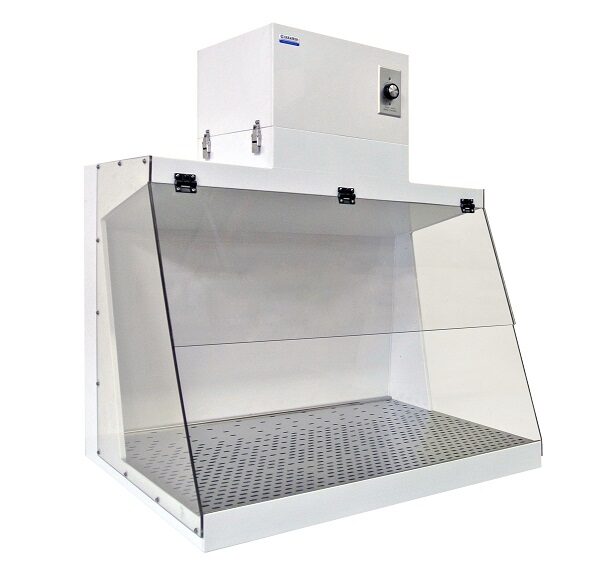Ductless downflow workstation is nothing but a greater performance ductless fume hood. A ductless fume hood is an enclosure that draws air across the work zone and its in-built carbon filtration or HEPA/ ULPA particle filtration cleans that air. It guards the person and the vicinity from toxic chemicals so that he can concentrate on his task. Downflow workstation is a ductless tabletop unit with an in-built blower. It is designed to protect the person working at the workstation and environment.
Ductless down flow workstation hugely involves the user and downward airflow into the chamber protects the user against dust, particles and vapor which is generated while accomplishing the work in the hood. Powder, vapor and harmful fume are trapped through perforations of the bench top and contaminant-free air is returned to the laboratory to protect the operator and the environment. It allows unrestricted front and side access to work zone. The improved filter clamping of ductless down flow workstation reduces bypass leakage. It gives low airflow alarm. This down flow hood protects the process, the lab operator and the environment from hazardous fume. Intensive operations and forensic fingerprint are the common uses of ductless down flow workstation.
What are the some basic features of ductless technology?
Some constituents of ductless technology are:
- Two or more workstations – They can be fitted side by side with union bond choice
- Filter I.D. Window – It monitors the installation date and ensures filter replacement timely.
- Hinged Front Sash – It protects the objects from external agent and separates the air.
- Control – It controls electronics and display.
- Pre-Filter – It helps to trap particles on the way to the main carbon filter.
- Filter Door key checks unauthorized removal or exposure to dirty filters.
- HEPA (High efficiency particulate air) / ULPA (Ultra low particulate air) can be added for the safety of the nature.
- There may be an activated charcoal filter (optional).
A HEPA filter is required when the applications involve powders and dry particles. When solvent chemicals are used, carbon filter is required.
What are the usages of ductless down flow workstation?
The ductless down flow workstations can be applied for preparation of chemicals, dental, forensic, industrial, handling pharmaceutical powder, microscopy, histology, powder finger printing, veterinary applications, welding electronic boards.
What are the advantages of ductless work flow station?
- Advanced carbon filtration technology Ductless down flow workstation provides a greater performance technology compared to traditional ducted fume hood. This can be applied to a wide range of application.
- Ductless down flow workstation trap chemical vapors while releasing into the environment. Thus it impacts on ecology.
- Ductless down flow workstation is self-contained and outside venting is not required. There are many units which are portable and can be moved without changing of filter and with negligible interruption. The installation process, operating process and filter maintenance of the down flow workstation are also not complicated.
- Since filtered air returns back to the room, use of ductless down flow is energy efficient
- There is no need of ductwork, planning or site modification, hence construction cost is less.
- Airflow of cabinet and face velocity of the down flow workstation protects the operator from exposure to smoke.
- Monitoring of continuous safety is done by electronic airflow. Electronic gas sensor checks the performance of the carbon filter.
- Pure air is recycled all over the work zone atmosphere without the need of additional energy.
- Laboratory staff is able to relocate it simply without involvement of any cost.
- Ideal as exhausted air does not create negative pressure
What are the disadvantages of a ductless workflow station?
- Ductless work flow stations have some disadvantages:
- Limited chemicals can be handled
- Filters need to be replaced
- For removing chemical fumes it is not effective.
What is the ideal ductless down flow workstation?
There should not be too much heating in the downflow workstation. At the workstation, not more than10 chemicals should be handled per application. Chemicals should be used in small volume and exposure time will be 2 – 3 hours per day. For ductless downflow station, a range of filters is there which have different chemicals capturing capacity. Bur the application should be matched with available filters. The life span of the filters depends on chemicals handled, chemical volume, evaporation rate, duration of usage, and the chemical’s temperature. A ductless downflow workstation is gaining popularity. The obvious reasons for its wining over ducked workstation are its associated cost-saving, mobility, energy efficiency. As there is no complex ductwork or infrastructural work requirement, ductless downflow workstation installation is convenient. Downflow workstation should be placed away from high traffic in the laboratory because the staff pass through the workstation may interrupt the flow of the air in the hood leading to turbulence and consequently fume in the laboratory.
